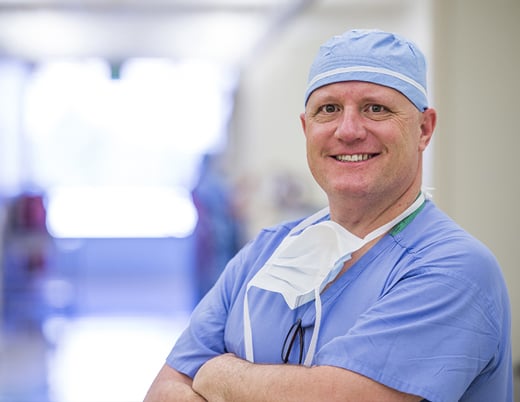Key takeaways
-
Prenatal detection of anorectal malformations is challenging, especially less severe forms.
-
Our researchers studied the feasibility of using routine prenatal ultrasounds to identify anal dimples (AD) to improve the detection of anorectal malformations.
-
In the longitudinal study of prenatal ultrasounds, the AD was observed in about 58% of cases.
Research background: prenatal diagnosis of anorectal malformations
It is difficult to detect and diagnose anorectal malformations prenatally, especially less severe forms. Identifying less severe forms could be possible if an abnormal location or absence of an opening is detected, such as rectovestibular fistula, rectourethral bulbar or prostatic fistula, rectobladder neck fistula and anorectal malformation without fistula in males and females.
The identification and evaluation of an anal dimple (AD) during routine prenatal ultrasounds may be a feasible way to detect the presence of an AD and make a diagnosis of an anorectal malformation. The appearance of the AD is described as a “predominantly rounded area of echogenicity surrounded by a rim of hypoechogenicity posterior to the fetal genitalia, resembling a ‘target sign.’”
Researchers from the International Center for Colorectal and Urogenital Care and Colorado Fetal Care Center at Children’s Hospital Colorado hypothesized that visualizing the AD in prenatal ultrasounds may help detect less severe types of anorectal malformations and impact pregnancy management and family counseling.
Research methods: prenatal ultrasounds
Researchers performed a longitudinal study of 372 pregnant women who underwent prenatal ultrasounds at the Colorado Fetal Care Center between January 2019 and October 2020. Fetuses with suspected anorectal malformations were excluded. A total of 900 ultrasounds were performed, evaluating 1,044 fetuses, with a gestational age range of 16 to 38 weeks. The mean number of ultrasounds per participant was two.
Data collection on fetuses included:
- Gestational age
- Singleton vs. multiple pregnancies
- Gender
- Visualization of AD
- Non-visualization of AD

Research results: role of age and position of the fetus in visualizing AD
Researchers found the following:
- In 612 fetuses (58.6%), the AD was visualized
- In 432 fetuses (41.4%), the AD was not visualized
- The two most common reasons for non-visualization:
- extreme gestational age
- fetal position
- The AD was visualized most often in 28 to 33 weeks (+ 6 days) gestation, with 78.1% success and was a statistically significant difference.
- The AD was most identifiable in singleton pregnancies, at 66.6% vs. 37.6% in multiple pregnancies.
- Gender did not play a role in the ability to visualize an AD.
- Of the 205 babies in the study at Children’s Colorado, only one had the most benign anorectal malformation type (recto-perineal fistula); all others had a normal anus.

| Crosstable of Anal Dimple Visualization on Static Stratification (age) | |||||||
|---|---|---|---|---|---|---|---|
| Stratification (age) | |||||||
| 16-21w+6d | 22-27w+6d | 28-33w+6d | 34w or more | Total | |||
| Anal Dimple | no | 174 | 86 | 79 | 93 | 432 | |
| Imaged on | % of total | 16.7% | 8.2% | 7.6% | 8.9% | 41.4% | |
| Static | yes | 4 | 132 | 281 | 195 | 612 | |
| % of total | 0.4% | 12.6% | 26.9% | 18.7% | 58.6% | ||
| Total | 178 | 218 | 360 | 288 | 1044 | ||
| % of total | 17.0% | 20.9% | 34.5% | 27.6% | 100.0% | ||
Research discussion: benefits of prenatal recognition of anorectal malformations
In utero recognition of anorectal malformations benefits the mother and fetus. Once AD is identified and the anorectal malformation is diagnosed as the underlying cause, healthcare professionals are able to better counsel patients. This includes both prenatal and perinatal management, such as identifying the proper facility for birth (a hospital with a level III neonatal intensive care unit and surgical capabilities), and counseling patients on the need for surgical intervention (most newborns with anorectal malformations will require surgery about 24 hours after birth).
To the researchers’ knowledge, this is the first U.S. study addressing the feasibility of visualizing AD in prenatal ultrasounds for anorectal malformation. The U.S. does not routinely examine AD in prenatal ultrasound because it is considered optional in national guidelines. Incidence of AD identification outside of this study was 16 to 42%. The AD identification rate when assessed by ultrasound encounter was 58% and 81% when assessed by individual fetus in this study. These rates are also consistent with findings in international studies, including a prior study from South Korea that demonstrated high rates in visualization.
One caveat for the success of these studies and an indicator of success in AD visualization was the age of the fetus at the time of the ultrasound. The optimal gestational age for the visualization of AD was between 28 and 33 weeks. In a histological evaluation, researchers found that fetal anal sphincter development is most active during the later gestational periods. This observation supports follow-up ultrasounds in cases where the AD was not initially identified.
Research conclusion: AD visualization and anorectal malformation detection
Researchers demonstrated that AD visualization in a prenatal ultrasound to detect an anorectal malformation is feasible. The optimal timing for AD visualization is late in the second and third trimester.
Featured Researchers

Andrea Bischoff, MD
Pediatric surgeon
International Center for Colorectal and Urogenital Care
Children's Hospital Colorado
Professor
Surgery-Peds Surgery
University of Colorado School of Medicine

Luis De La Torre-Mondragon, MD
Pediatric colorectal surgeon
International Center for Colorectal and Urogenital Care
Children's Hospital Colorado
Associate professor
Surgery-Peds Surgery
University of Colorado School of Medicine

Mariana Meyers, MD
Director of Fetal Imaging
Vice Chief of Operations, Pediatric Radiology
Children’s Hospital Colorado
Associate professor
Pediatric Radiology
University of Colorado School of Medicine

David Mirsky, MD
Pediatric neuroradiologist
Pediatric Radiology and Imaging
Children's Hospital Colorado
Associate professor
Radiology-Pediatric Radiology
University of Colorado School of Medicine

Alberto Peña, MD
Founding Director
International Center for Colorectal and Urogenital Care
Children's Hospital Colorado
Professor emeritus
Surgery

Michael Zaretsky, MD
Director of Research
Colorado Fetal Care Center
Children's Hospital Colorado
Professor
OB-GYN-Maternal Fetal Medicine
University of Colorado School of Medicine





 720-777-0123
720-777-0123










